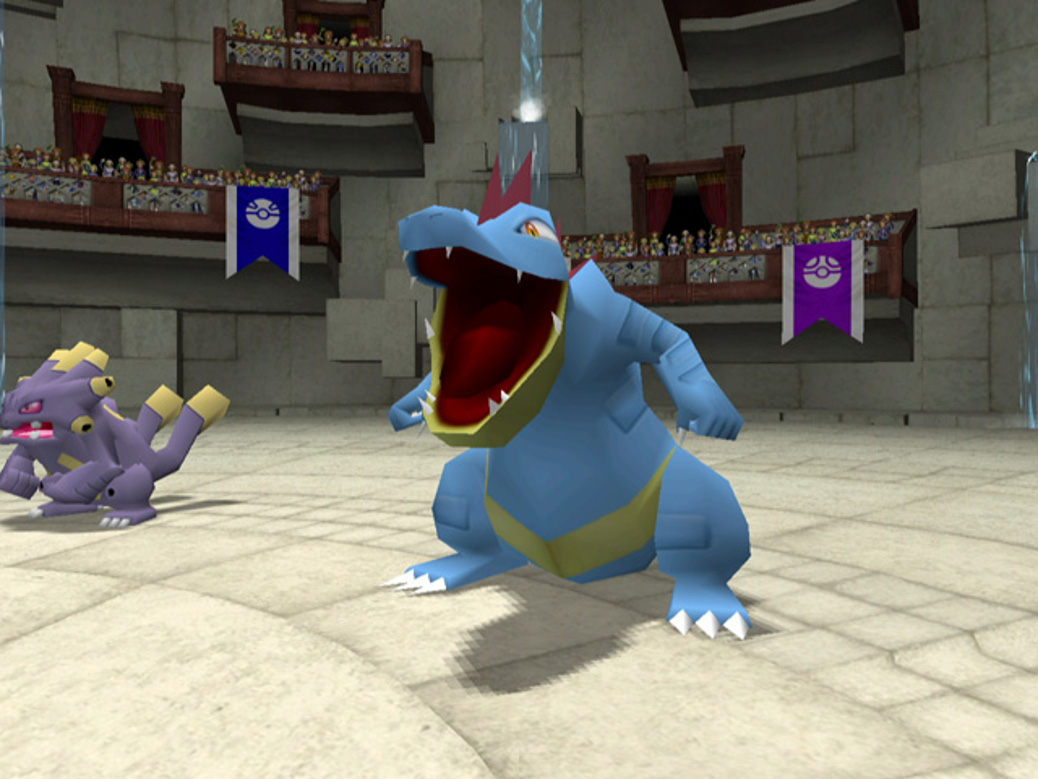‘Pokemon Colosseum’ was the best-selling RPG released on the GameCube. (Courtesy of The Pokemon Company)
Shane Foley
Connector Staff
In comparison to its two predecessors, “Pokemon Colosseum” was a large departure for the line of main console “Pokemon” games.
Although the “Pokemon Stadium” entries were popular, The Pokemon Company elected to stray away from the multiplayer experience to a more single player focus. They hired Genius Sonority, later known for their work on the Dragon Quest series, to create a 3-D action adventure role-playing game (RPG) with all the trimmings of a “Zelda” or “Skyrim” game with the good old mechanics “Pokemon” fans have grown to love. As appealing as that may sound on paper, however, the result was more akin to the typical “Pokemon” experience with a lot more walking around.
In “Pokemon Colosseum,” the player assumes the persona of Wes, a name that has no relevance to “Pokemon” or Nintendo. Wes is a former member of Team Snagem, a cohort that has gained recent notoriety for stealing Pokemon. Wes has left the team, realizing the error of his ways, but as he does mysterious shadow Pokemon appear over the region of Orre. Wes and his companion, Rui, embark on a journey to uncover what is going on with shadow Pokemon and to what end forces of evil are using them for.
While maintaining much of the typical aspects of an enjoyable “Pokemon” game, there is one blaring mechanic that can prove to be quite irritating, and that is Pokemon capture. There are no wild Pokemon in this game, nor are there wild areas, like grass. The only means of acquiring new Pokemon is through using Poke Balls on shadow Pokemon, which are basically Pokemon on other trainers’ teams that can be caught. In essence, the player does “steal” the Pokemon, which is a departure from a common theme in the games.
What makes this mechanic irritating is what happens after they are captured. Shadow Pokemon do not belong to the player after they are caught like in other games. Instead, the Pokemon must go through a process of purification. Before that process is completed, the Pokemon still retains its shadow form, which means it can only use the move Shadow Rush, though it learns more moves as it purifies.
In order to purify shadow Pokemon, the player has several methods to select from. Using a shadow Pokemon in battle decreases its shadow meter. In battle, when using the move Shadow Rush, the Pokemon may start to glow, in which case selecting “call back” will let its shadow meter decrease or using the attack will result in a critical hit. There are also items that lower the shadow meter as well. Unfortunately, all of these methods are very slow, which is why this is irritating.
There are special items in the game that instantly purify the Pokemon. Unfortunately, only about three exist in the entire game though. They have a large rarity assigned to them, like Max Revives in the main Pokemon series. Walking around also decreases the shadow meter, albeit very slowly. A common strategy is to walk to many places when purifying the players Pokemon.
Not only is purifying shadow Pokemon a long and arduous task, but the Pokemon that have to be purified are not exactly appealing. The player can select a starter and are given a free Espeon and Umbreon. From there, the shadow Pokemon available are Pokemon like Makuhita, Hitmontop, Yanma and Pokemon of the like for about two-thirds of the game. Towards the later half, players begin to see Metagross and Tyranitar. The Legendary Dogs are also available (Entei, Raikou and Suicune), but they are very difficult to catch.
Level design is also an issue here. The map is somewhat small, and the player spends the majority of their time in three areas (Phenac City, Pyrite Town and Agate Village). There also is not much to do in these areas, and because of purification, one might end up walking these streets quite often. Pyrite Town has some secret areas, but other places have a couple non-player characters (NPCs) and not many houses to enter. The region of Orre is also based on a desert, so do not expect amazing 3-D landscapes or anything. That being said, some areas in the endgame are quite impressive.
Overall, this title falls into the rating of a D. This might be a low score to give a game that was quite popular on release. Back in 2004 though, watching Pokemon in full 3-D was quite a big deal, more so than in 2017. Plus, after dealing with the shadow Pokemon, playing this game might leave some wishing they had Pokemon Ruby or Sapphire instead. This game is a staple of its time though, so the nostalgia factor is real.

